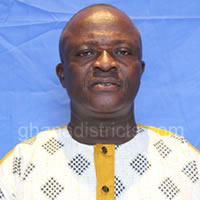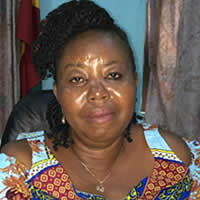Demographic Characteristics
Population Size and Growth
The District had a total population of about 119,180 consisting of 61,090 (51.3%) and 58,090 (48.7) in 2010. This accounted, for about 2.5 percent and 0.5 percent of the population of Ashanti Region and Ghana respectively in 2010. With this population, the Atwima Mponua District was the ninth populous district in the region with Kumasi Metropolis (2,035,064) recording the highest and the least is Offinso North District (56,881). The District recorded an annual average intercensal growth rate of 0.9 percent which is lower compared with the regional average of 2.7 percent and national average of 2.5 percent. With the assumption that the intercensal growth rate of 0.9 percent would be constant as well as other factors affecting population will remain the same, the District is projected to 126,894 in 2017 (using the exponential method). This means that the District has the potential to increase in size and grow to support any development in the District.
Population Density
The total land area of the District is approximately 1,883.2 square kilometres. This gives population density of 63 persons per square kilometer in 2010. The projected population of 126,894 represents a population density of 67 per square kilometer. The implications of the high population growth and density reflect in demand and pressure on infrastructure, food supply, energy, water and other services. However, the recent slowdown in illegal mining activities in district is likely to witness a high population outmigration especially the migrants who came purposely for mining.
Population Distribution of Urban and Rural Localities
In Ghana, the classification of a locality as urban or rural is primarily based on population size. Settlements with population of 5,000 or more are classified as urban and those below 5,000 as rural (GSS, 2013a). Based on this criterion, the Atwima Mponua District is therefore predominantly rural as 87.6 percent of the population resides in the rural localities, with only 12.4 percent staying in the urban localities. Out of the 310 communities, only Nyinahin and Mpasatia are urban settlement constituting 0.9 percent as against the remaining 99.1 percent as rural localities. However, there is increasing peri-urban communities in the district.
Economically Active Population
For the economically active population, about 97 percent (96.9%) are employed as against 3.1 percent who are unemployed. However, the unemployed proportion has majority of them (72.7%) seeking for work for the first time compared with worked before and seeking for work (27.3%). Moreover, out of the economically not active population, the proportion of full time education (56.1%) dominates followed by home duties (20.3%) and too old/young (10.2%), and the last is pensioners/retired (1.0%). In addition, it is worth mentioning that 6.4 percent were economically not active population because they are disabled/sick persons.
Informal private sector is by far the largest employer of economically active persons in the District (96.1%), followed by public (government) sector (2.4%). Less than two percent of employees are in private formal (1.2%), NGOs (0.3%), semi-public/parasatal (0.01%), or other international organization (0.002%).
Migration (Emigration and Immigration)
Out of the District’s total projected population of 126,984, migrants formed 48,949 representing 38.5 percent. This means that 61.5 percent are born in the locality of enumeration. Out of the 48,949 migrants, 86.6 percent has taken up permanent residence which needs to be factored into the development agenda of the District.
The high number of migrants in district is triggered by the farming and mining potentials in the district. Sustainable farming and mining methods are therefore, critical for sustainable development in the district.
Gender Equality
The 2010 Population and Housing Census conducted by the GSS put the District population at 119,180 with 61,090 males and 58,090 females. The District has almost half (48.5 percent) of its
Gender defines the roles and responsibilities that women, men, girls and boys have in a given context and culture. It varies according to culture. Women in the district assume the basic domestic and childcare roles. Both genders assume responsibility for basic agriculture production, although men undertake the more laborious tasks and women the more repetitive ones. Women will work on their husbands’ farms but will also farm on their own. Women in the district assume important social, political, and ritual roles. Within the lineage and extended family, female elders assume authority, predominantly over other women. The oldest women are considered to be the ablest advisers and the repositories of family histories. Boys and girls perform similar roles and responsibilities like the adults do after school hours. Boys help their farmers on the farm during non-school hours whilst the girls perform home chores such sweepings, washing of utensils, taking care of their siblings among others.
Lands in the district are owned by the chiefs on part of the people. Both men and women do not own land in the district, however, with access to land especially for agriculture purpose is dominated by men. Women access land from the chiefs through the men.
There is high disparity between males and females in almost all institutions. This is more serious in the field of governance. The District Assembly currently has 57 members composed of one District Chief Executive, one Member of Parliament, 38 Elected Assembly Members and 17 others appointed by the Government in consultation with the Traditional Authorities and Other Opinion Leaders in the District. This is made up of 54 males representing 94 percent and three females accounting for 5.3percent. This is low participation of women in the political life in the district.
1.6.11.1 Key Gender Issues in the District
Inadequate basic social services (health, education, water and sanitation
Low representation of women in politics in the district
Limited access to land and other productive resources by women for agriculture purposes
Socio-cultural, traditional beliefs and socialization
In the educational institutions, the situation can be normal consideration the male proportion in the total population. However, the gender parity index widens towards the senior high level.
At the primary level, total enrolment stood at 24, 308 pupils consisting 51.53 percent males and 48.7 percent females. In the JHS level, total enrolment stood at 8, 707 students making up of 54.14 males and 45.86 percent female. Finally, at the SHS level, total enrolment is 2,094 representing 58.4 percent males and 41.6 percent females.
Development Implication
The analysis implies that, the level of women participation in decision making as well as carrying out development activities is very low. This however tends to hinder development in the District since women are focal point when it comes to sustainable human development. Policies emanating from decision making processes tend to favour males since they are the majority in the District. The District should therefore embark on women empowerment so as to engage more women in all institutions in the District participate in the decision making processes of the district. In addition, socio-cultural practices that do not allow women have access to land, credit and other productive resources be avoided.
Settlement System
Spatial Analysis (Settlement Systems)
The District operates not in isolation, but depends on other districts. There is therefore, exogenous and endogenous flow of goods and services amongst the linked districts. The Atwima Mponua District interacts economically with the Atwima Nwabiagya District. The Atwima Nwabiagya District provides market for most of the farm produce of the farmers in the district and provides some educational and health needs to meet the needs of some members of the District.
The Amansie West District, a neighboring district, also provides markets for farmers and economic actors in the district. Likewise the Atwima Nwabiagya District, the Amansie West District also has educational and health facilities which serve the needs of members in the Atwima Mponua District. The Ahafo Ano South District and the Bibiani Anwhiaso-Bekwai District also provide similar economic support like the other districts aforementioned to enhance the growth and development of the Atwima Mponua District. The economic interactions between the district and the adjoining districts signifies the need for collaborative support and initiatives to ensure mutual benefits as an attempt in expanding Local Economic Development (LED).
Date Created : 11/24/2017 12:57:04 AM






 facebook
facebook twitter
twitter Youtube
Youtube TOLL FREE 0800 430 430
TOLL FREE 0800 430 430 +233 593 831 280
+233 593 831 280 GPS: GE-231-4383
GPS: GE-231-4383 info@ghanadistricts.com
info@ghanadistricts.com Box GP1044, Accra, Ghana
Box GP1044, Accra, Ghana